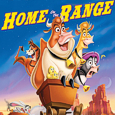Walt Disney Feature Animation (April 2 2004), Walt Disney Home Entertainment (September 14 2004), single disc, 76 mins plus supplements, 1.66:1 anamorphic widescreen, Dolby Digital 5.1 Surround, Rated PG, Retail: $29.99
Storyboard:
The last (for now) traditionally produced animated feature from the Mouse House, Home On The Range’s wild-west spoof story is as basic as can be, with lady Pearl’s farm, dubbed her little Patch Of Heaven, up for lease renewal. This comes in handy for one Y. Odel, who has been buying up lots of land in the area due to lower rates brought on by cattle rustler Alameda Slim. Turns out that Slim and Odel are one and the same, with Slim’s boys downing the land price by getting folks to shut up shop and move out, while Odel moves in and buys up the land – and the stock – at cut price rates! With Pearl’s farm on the block, her animal herd is joined by Maggie, orphaned from one of Slim’s rustling outings, who gets it into her head that she can help her new family by teaming up with the two other cows on the lot, Mrs Caloway and Grace, to track and capture Alameda Slim and gain the reward money…you got it – exactly the $750 needed to save Pearl’s Patch Of Heaven farm!
And so they set out, up against a mysterious bounty hunter, Rico, and Buck, a crazy horse from the Sheriff’s office who’s out to impress Rico and become his ridin’ pardner. They’re all in for much more than they bargained for, however, when they catch up with Slim and find that his favored “secret weapon”, a crazy yodel, is enough to enchant any cow and send them willingly off to the slaughter! Will Rico get there in time? Will Buck shape up and become the hero he dreams himself as? Or will our “bovine bounty hunters” end up headed for the chops and not even good enough for milkshakes? Looks like the stage is set for a good old-fashioned showdown…
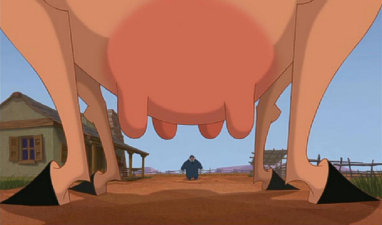
The Sweatbox Review:
I have to admit to shedding a tear or two on the way to the theater to catch Disney’s farewell to traditional Burbank-drawn hand animation when it was released just one month ago in the UK. Until the Studio sets itself right and decides to pick up the pencils again, it’s a future of “diet Disney” on the cards: sequels and knock-offs from the direct-to-video Toon Studios down under. Broken for the first time in over 20 years is the production line that started with Snow White And The Seven Dwarfs in 1937, and continued through Walt’s death with The Jungle Book. Even in the early 80s, when Disney Feature Animation looked doomed and there was not anything in production other than the fated Black Cauldron, there was the hope of Musker and Clements’ return to casting mice at Disney, with the result that The Great Mouse Detective kick started a new trend of non-stop production and hits, resulting in the Academy Award nod for Beauty And The Beast and the box-office domination of The Lion King.
In many ways, it was that film that both validated Disney animation as a commercially sustainable art form…and began the slow road to killing it off at the same time. The “toon boom” of the 1990s led to a variety of companies stepping into the field, not least Disney’s own partnership with Pixar and the rise of PDI/DreamWorks, their biggest rival. With these two new kids on the block, providing the whiz-bang fireworks of Toy Story and Shrek, no wonder handcrafted, “old-school” Disney began to look old hat. Now, I loved the recent Disney films, especially Tarzan, Lilo And Stitch and Treasure Planet…but I can see the argument that they are formulaic, old-fashioned in tone and almost carbon-copies of themselves and have to admit that, yes, that is primarily the case. Once upon a time, Disney films were fresh. Recently, and including Lilo And Stitch at its core sentiment, they have become the same film, dressed in ever increasingly opulent visuals.
The boom of CGI’d productions has coincided with the general dumbing-down of movies, due in part to special effects, where now anything is possible and every new film must top the last. Where CGI animated films have had most success is in the rather bland, easy to please family comedy market – where, let’s not forget, the traditional Lilo And Stitch was also a hit – while the studio suits fail to see that it’s the material and not the technique that provides the audience (no-one ever mentions the failure of Final Fantasy, the CG film in the vein of Titan AE and Atlantis: The Lost Empire). Skewing their animated attempts to appeal to this demographic, Disney have strayed away from what kept them at the top of the animation game in the 1980s and 90s, trying to find a “please all” solution. News continues to filter through that several big epic productions were turned around and switched into outrageous comedies: The Emperor’s New Groove started out as a dark and serious Prince And The Pauper tale called Kingdom In The Sun.

Into this fray steps Home On The Range, itself finally released as a broad comedy after several years (and even more re-writes) on the boards as a widescreen epic named Sweating Bullets, about a young bull’s adventures in an old western ghost town. If this sounds a little more sombre than the humorous bovines we come to know in the movie as it is now, well, you can thank DreamWorks’ Spirit: Stallion Of The Cimarron, which under performed and led Disney to change tact on its own horsey movie. Even as such, Home On The Range came and went pretty quietly earlier this year, without much of an eventual fanfare from the Mouse House, and overall mixed reviews from critics.
Whereas The Emperor’s New Groove just about passed the test, and all holes were covered up between the original intentions and the final result, Home On The Range feels a little more disjointed, and the short running time doesn’t help hide the fact that it looks like it’s been stitched together as quickly as possible. In fact, this animated adventure was ready to roll into theaters a full year ago, though the Studio decided to rush Brother Bear’s production through in order to coincide the release with The Lion King on DVD last fall. In a way, I’m glad for that, since it means that if this IS the end of Disney’s traditionally animated feature films, the “honor” at least falls to a production realised at the Burbank facility that championed the art form for all these years. Not that I haven’t enjoyed the Florida animated features, and true that they did contribute much to the recent Burbank features too, but I do find a simplicity to some of those films in some of their personality animation.
That’s an interesting line to take with Home On The Range too, which does sport a simpler, more angular look that’s more associated by most to the Warner Brothers Looney Tunes cartoons (the backgrounds are very reminiscent of Chuck Jones’ Road Runner shorts). In fact, Walt himself began this trend in Disney pictures with shorts such as Pigs Is Pigs (the title characters of which bear a striking similarity with the pork choppers in Home On The Range). Recently, the same style was adapted as the look for The Emperor’s New Groove, and there’s no denying that Home On The Range shares more than just this with that film (even counting their joint, troubled production histories).
This 1950s style fits right in to the shorts made around this time (Disney put out a fair share, including Paul Bunyan, which feature this look) and only looks “new” thanks to the more refined outlines computer assisted production can bring, and the spot, here are there, of CG-enhanced props and backgrounds. For the most part though, it’s good old painted artwork throughout, something that lends the film a charm that could otherwise be missing. The designs are certainly nothing to shout out about, and, as even touched on above, supporting cast members look as if they’ve been pulled from older Disney cartoons (could this be intentional?) and seem more than familiar. But it’s all animated with that unmistakable fluid Disney-animation technique, with fine, flowing lines and movement that somehow always works, even when we are more used to seeing these kind of designs treated more aggressively in more vigorous shorts and films.
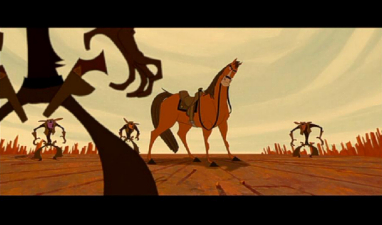
While the designs may be as good as they need to be and the animation as good as we expect it to be, there are a few added layers which help lift Home On The Range JUST above the status of a rudimentary affair. Buck’s visions of himself as a Wild West hero mark some of the best work in the film, with darker lighting and a more dangerous tone brought in to offset his wackiness. These sequences also narrow down to a 2.35:1 ratio (rather than opening up wider, Brother Bear style), with black mattes filling in top and bottom to create the classic western film frame of a Sergio Leone epic (touches of Ennio Morricone’s musical mark in the score at these points too). Likewise, some of the characters are big, big plusses, such as Lucky Jack, a not-so-lucky jack rabbit who helps the cow-girls on their quest and Slim’s assistants, the Willie Brothers – possibly the dumbest fun characters in all things Disney (and is that a nod to Ward Kimball when one of them dons glasses?)
Adding to the characters are the spirited performances, among them Roseanne Barr as Maggie, Judi Dench as Caloway and Jennifer Tilly, here not playing against her general image as dumb blonde Grace. Randy Quaid, as Slim, isn’t given too much to do, but he chews each scene up with relish, while a couple of surprise “cameo roles” go to Steve Buscemi and Patrick Warburton, who provides one of the biggest laughs with his offhand delivery in his brief single scene. As a comedienne, Barr has never been known for her subtlety, and here she plays it just like her TV show appearances. It’s an infectious approach to be sure, but one that may be a little overbearing for the film: we’re never in doubt as to who the “star” is. Dench is a little more relaxed, bringing, appropriately, a warm tone to the film and subtle depth in the acting, which helps the more resonant parts hit home more.
Of the music, Home On The Range supposedly marks the long awaited return to Disney features by Alan Menken, the multi-Academy Award winner for such traditional scores as Aladdin, Little Mermaid and Beauty And The Beast. He’s been more and more absent of late, concentrating instead on the stage translations of those films, but it’s good to have him back. In a strange way, his work here compliments the film perfectly, not being anything near as memorable as his previous Disney outings, though not badly written. Menken doesn’t really play with western conventions in the music, apart from a predictable honky-tonk piano, banjo and some heart-pulling harmonica, and to be honest I felt the score was secondary to the dialogue and songs for much of this time around. That’s not normally the case with a Menken score, which frequently belongs in, and lifts every scene.
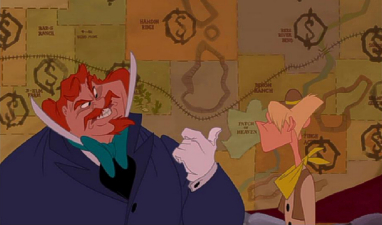
The Yodel-Adle-Eedle-Idle-Oo song, sung by Randy Quaid (with a bit of yodelling help) as Alameda Slim, seems to be the high point that people come away humming, but it didn’t quite work for me. Certainly, lyricist Glenn Slater doesn’t have the knack for colourful word play that Menken’s late partner Howard Ashman did. There seems to be a lack of inspiration here, and even with comedy material like this, which Menken usually excels with (as in Little Shop Of Horrors and Hercules), Slater can’t seem to jump start the show. Some lines just about work (“Out where the fearless get the shudders, Justice is here, and it’s wearin’ udders”) but for the most part, I found the intended emotional wallop of Will The Sun Ever Shine Again? (sung by Bonnie Raitt, sounding very much like a young Bette Midler) to be the film’s most memorable melody. Even here though, I was reminded of When She Loved Me, from Toy Story 2, a prompt which further suggests that, while Home On The Range is a new film, it can seem awfully over familiar at times.
The score offers an interesting cross of styles, being a combination of character-led songs and the overlaid tracks we’ve come to be used to in recent Disney fare. It works, though, and even when characters are not singing directly on-screen, one gets the feeling that this is what their inner-voice feelings are saying, more so than Phil Collins’ tracks for Tarzan and Brother Bear, which seemed to imply more of a forward momentum “story song” or thought process. Nevertheless, it’s great to have Menken “back in the saddle”, and the fact that he even gets to feature notably on the film’s soundtrack is testament to his talents as a songwriter and singer.
The ups and downs of production obviously had a few effects on the final film, but for the most part any cracks have been papered over well, and even Maggie’s narration – usually the first sign that a film has been stitched together and a voice track used as glue – seems to flow naturally and never feels shoe-horned in at the last minute. As for the PG rating, well, apart from one line (the now udderly famous “yeah, they’re real!”), there’s really nothing to get upset about, and the rest of the film actually plays on a slightly lower level and is certainly aimed more at kids, with now seemingly obligatory wind gags included, but don’t worry – there’s nothing Blazing Saddles about this film!
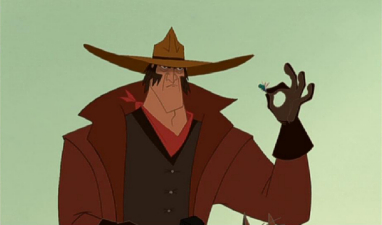
Animated westerns have always been hit and miss affairs. It’s certainly worth hunting down the English-language dub (by Rich Little) of the original French feature Lucky Luke to see how it can be done right. On the knock side, Spirit: Stallion Of The Cimarron was a drawn-out cross-country ride, and even Fieval Goes West, the sequel to An American Tail, was only saved from total confusion by some touching moments thanks to James Stewart’s delicate vocal readings. Home On The Range, officially Disney’s 44th and final animated film in the list that starts with Snow White, just about gets it right. It’s not as funny as it wants to be, nor as emotionally charged as it could be, but serves to point out that Disney animation still works, and works well, and even with its simplified storyline is a lot more coherent than the majority of such other efforts.
It’s not the all-out, singing and dancing showstopper that many of us would have liked to see Disney animation go out with (and was mooted at in early news on the film: “yes, we have singing cows”, as was revealed by Disney president Dick Cook, conjures up a whole bunch of situations that this film cries out for), but it’s no last horse (or should that be cow?) at the post either. Home On The Range offers some fast-paced fun in an economically told fashion, and while it’s not quite top-drawer Disney, the film scores way more than all those second-rate animated features out there. There’s no doubting the sheer professionalism on show, and Home On The Range proves that Disney can still be the best at what they do!
Is This Thing Loaded?
As with Treasure Planet, Home On The Range’s lacklustre box-office returns put the breaks on an expanded double-disc set, but, and also like Treasure Planet, it doesn’t mean that it’s not a pretty packed single, with a couple of real surprises! Kicking off the disc are Sneak Peeks for the DVD special editions for Aladdin and Mulan, and the tripe Twice Upon A Christmas (tagline: here’s what NOT to fill Christmas stockings with!), as well as the theatrical Pooh’s Heffalump Movie. Via the dedicated previews menu there are additional looks at The Magical World Of Winnie The Pooh, ToonTown Online and the Home On The Range soundtrack (here spelt incorrectly as “sountrack”!), but of course no actual trailers for the film itself!
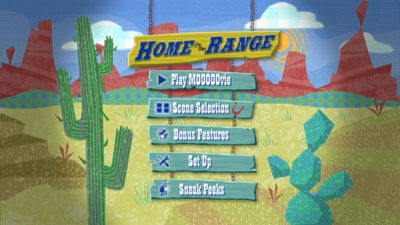
Heading towards the Main Menu, and a fun feature is one of three randomly selected “intros” that discuss and riff on the DVD experience (voiced by the main cast with cute images of their characters rendered as they might be in a children’s storybook). These roughly one minute sequences are fun, and more than anything display that Disney hasn’t taken a cutback approach to the disc, even if it is a single issue. The menus are designed as per the “new” EasyFind system, which doesn’t do anything older Disney DVDs didn’t, except given all the bonus features their own heading and icon (I still don’t see the benefit of this), and then we’re on to the extras proper…
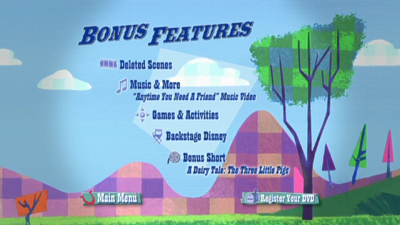
In Backstage Disney, you’ll find perhaps the best and meatiest of this disc’s features, a full-length Audio Commentary with the Writers/Directors, Will Finn and John Sanford, as well as producer Alice Dewey-Goldstone. For some strange reason, Disney has been very shy about advertising their commentary tracks on some releases (Sleeping Beauty, The Lion King), especially in press releases, but Home On The Range goes one further – it isn’t even mentioned anywhere on the packaging either! Nevertheless, this is where Disney fans should go first, with the three participants really opening up about the production, explaining where the many story changes took place and where characters were switched from various scenes. The amiable trio carry the conversation well throughout the film’s length, pointing out their own vocal and character “cameos”, as well as how they wanted to get away from the “pretentious” recent animated features and just “do something fun”, plus the use of belching in animated films! Absurd as to why this is not mentioned anywhere in the point-of-sale material, it’s a welcome addition, and one that definitely marks the disc up in terms of attention the title has received.
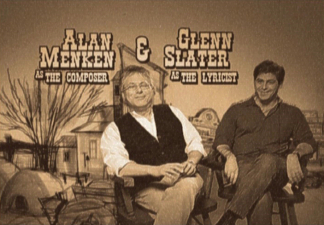
Staying “backstage”, and the almost 17-minute Trailblazers: The Making Of Home On The Range featurette covers the basics and more in its packed running time. The history of the film as Sweating Bullets is touched on, as well as story inspirations and the history of the animated West in Disney cartoons. As well as writer/directors Finn and Sanford, we hear from composer Alan Menken and lyricist Glenn Slater, a nice nod to the musical score, which so often gets overlooked in these kinds of behind-the-scenes efforts. This is a great little piece (with a fun silent movie opening), never becoming too full of fluff and always concentrated on the task at hand: profiling the production of the film. Around ten of the principal crew get a moment to say what they have to say, and though one may wish that it were a teensy bit longer, there’s nothing that could really be added to here.
Rounding out this section, and complementing the developmental aspect of the commentary and the featurette is a ten-minute Art Review featurette, narrated by art director David Cutler and head of backgrounds Cristy Maltese. A collection of photos from a trip to Wyoming, concept art, production stills and character designs, this feature, as with the similar one on the Brother Bear DVD, neatly wraps up the visual development into one package, with the bonus of having the artists on hand to deliver more info on an image than a stills gallery ever could. A bonus is the fact that the viewer can pause the clip at anytime to take in any of the artwork that may fly by a little too quickly.
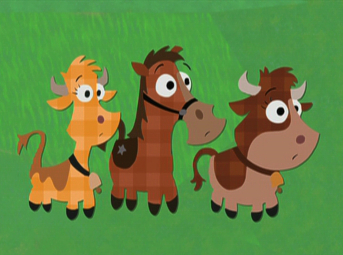
Next up, and possible the most eagerly awaited by fans, is A Dairy Tale: The Three Little Pigs. In the mid-1990s, Disney sponsored a series of Totally Twisted Fairytales – three modern takes on classic stories, similar to Jay Ward’s Fractured Fairytales series of the 1960s. One of these was a re-imagining of Walt’s short The Three Little Pigs (the other two were Little Redux Riding Hood and Jack And The Beanstock), and it was widely hoped that it would be the short included here. Unfortunately, it’s not the same short…but fortunately, it IS a very funny new cartoon directed by Finn and Sandford and featuring the bovine stars (and original voices) of Home On The Range! The short uses the same “storybook” style as the disc’s main menus (which take their lead from the film’s closing credits), with cuter, rounder renderings of the main characters bumbling their way through Mrs Caloway’s reading of The Three Pigs. At just around three minutes, it’s a short and sweet affair, but snappily paced, and one that is again both surprising and most welcome.
Heading back out onto the main bonus menu and we find a bunch of Deleted Scenes cut from the picture. Played with opening remarks from the directors, there are four scenes here that add up to around 15 minutes of screen time (in letterboxed widescreen). The usual blend of storyboard and rough animation, these were clearly abandoned concepts that were left by the wayside long ago as the film twist and turned through developmental changes. A couple of them look fun enough to have been worked into the film again, especially the butterfly narrators (which open the film in a wildly different style ten times better than the bland and obvious take we end up with) that features a completed deleted song. A thrilling coyote chase and an extended scene with Lucky Jack meeting the cows would have bolstered the overall running time of the feature, but they were all cut with reasonable grounds and at least we get to see them here.
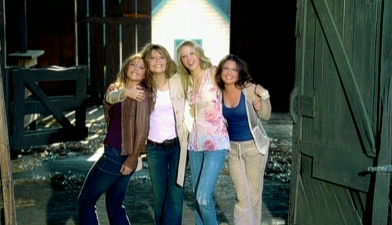
The last video-based extra is a Music Video clip for Anytime You Need A Friend, performed, as on the closing credits, by the Beu Sisters. A fairly standard promo, this has the aforementioned (and very photogenic!) girls singing the song in a farm setting (presumably to hint at the western theme) interspersed with shots from the animated moooovie (oh, come on, I had to put that somewhere)! A good enough track, and a fine example of a film/pop crossover song, well produced and as close to promotional material we get for the film on this disc release, it runs just over a full three minutes…looks like Disney has finally gotten the message about cut-down music clips that simply advertise the CD soundtrack.
Finally, in the Games And Activities section, there are a few mild diversions, all of them geared, as we may expect, to younger players. The Joke Corral offers a series of sequences with the film’s characters telling jokes…it’s that simple, though thoroughly enjoyable if you’re someone like me who groans with laughter whenever a lame pun is banded about! The jokes (around 18 of ’em, complete with purposely tacky studio laughter), are grouped either individually or as a play all selection, running four-and-a-half minutes, with limited animation that fits in well with the menu design and the Three Pigs short, all in 16×9 anamorphic widescreen. There’s a Tell Your Own Joke option, but bizarrely this just provides random comebacks to the viewer’s remarks…not a very successful after thought.
Yodel Mania! provides more interactivity with two options: a Yodel Memory! game and the Yodelmentary featurette. The game is your typical memory set up, being a series of listen/watch and repeat scenes. Characters pop out of barnyard doors, with a new one added each time the player guesses correctly, until – if you get through – a second, more complicated round takes place. More than anything on the disc, this is geared towards kids, who will probably have fun, but it is limited: choices are the same each time you play and there’s no real randomness to it. The Yodelmentary featurette adds up to just over two-and-a-half minutes of mixed-media footage that provides a snappy history of yodelling, again a bit of kids fun and in keeping with a theme from the main feature.

Finally, a 50-second preview for a Yodel Maker is featured, pleasingly pointing not to a cash-in separate game purchase, but to Disney’s first DVD-ROM feature in quite a while! The Studio’s last few discs have only included the InterActual Player and customised interface as extras, with a link to register your disc only. In a nice surprise, and adding to the overall good job that Disney has done here, is a new feature, the Yodel Maker. Using a microphone and your own images, the software allows for some comical manipulation (system requirements permitting of course). For those without a mic, a selection of pre-recorded yodels make sure that everyone can join in the fun. Okay, so it’s not the greatest addition to a DVD in the world, but a good touch and nice to see that Disney are thinking more about using DVD’s full capability again. I couldn’t try it out, but unusually the disc also apparently sports support for Apple Mac users too!
I have to say that, given the poor reception at the box office, it’s nice to see that, as with Treasure Planet again, Disney has not decided to issue a bare bones, no frills disc. Though a trailer or two would have been welcome, Home On The Range was previewed relentlessly in its theatrical run up and I’d be surprised if you didn’t already have one tucked away on a previous Disney disc or two in your collections. This disc admirably covers the basics in terms of what a 2-disc set would have done (and saves us a redundant full-screen transfer that would have undoubtedly filled much of that space), with extras that are enlightening, surprisingly in-depth and filled with a lot of entertainment!
Case Study:
In keeping with the decent approach that the Buena Vista team has taken with Home On The Range’s disc debut, a four page DVD Guide provides a nice change to the standard one-page insert, or worse still, no insert at all. Featuring scene selections and a write up of the supplemental extras (which does include mention of the Audio Commentary here only), the guide also “maps out” where to find things on the disc in the old-style way that the lavish two-disc sets used to do. A nice touch, again raising the overall mark of the disc up a notch or two, while another smaller booklet offers the usual money-off coupons and one-page ads for other Disney titles. A front sticker promotes the CD soundtrack again, which is most notable for giving Alan Menken himself a prominent role, singing a fully produced version of Anytime You Need A Friend, and it’s great to finally have him take some of the credit after many years of writing songs that other people end up singing!
Ink And Paint:
Presented in its original negative ratio of 1.66:1, Home On The Range has been anamorphically encoded for 16×9 displays and is the usual high satisfactory job from Buena Vista. Being another direct digital-to-digital transfer, the usual pros and cons arise…the pros being an absolutely terrific image, spotless and solid as one would expect (and the short running time of the feature can only help this more) with no compression artefacts, and in a good turn from Disney this time around, no excessive edge enhancement. The trade-off is a personal complaint of mine, in that some of these direct-digital transfers can look at bit too clean and “clinical”. Also, given the bright color palette, the film does sometimes resemble the blander, DTV output from the Studio (or could that just be because the DTVs are approaching feature quality with every passing release?) – nevertheless it’s a personal gripe and one that won’t upset too many purists! A terrific image.

Scratch Tracks:
When I saw Home On The Range in the theater, I was struck at how mishandled the sound mix was and was very interested to hear it on DVD and hoping for a better representation. For the most part the soundtrack is up to par, with comical effects and the music/songs placed just right in the mix and sounding as good and wide as the recent Disney pictures have done. However, and especially in the last reel, which is where things were most disappointed in the theater, everything seems to come crashing down, with dialogue fighting effects and everything else fighting Menken’s music score, which in the last few climatic chase moments, seems too buried for long periods of time.
Certainly, I was surprised to see the otherwise fine audio engineers Terry Porter and Mel Metcalfe on the job, since their work has always pleased before. A DTS track may have “opened up” the sound, as we’ve been getting on recent Disney DVD fare, but alas there isn’t the space for it here, given the supplements. The soundtrack, in Dolby Digital 5.1, is as good as can be expected based on the original mix, and perhaps is just another personal grumble on my part – with all the frantic action going on in the scenes at these points, I doubt anyone else will bother to care. The track certainly does the job. A THX Optimzer is also handy for system calibration, and there’s also a French language dub and English subtitles.
Final Cut:
With Home On The Range heading into theaters not more than five months ago, it may well be that audiences would rather wait and catch Disney’s latest productions on home video rather than on the big screen, where they belong. The “latest Disney” has always been a big deal for us true fans, and while the company may be diluting its own uniqueness with an influx of similar product, it’s films like Home On The Range on that their energies should be focused. Disney animation needs to change and evolve, but it is a real shame that the plug has simply been pulled on traditional fare such as this, when the medium obviously has so much still to offer. It’s been a great ride getting here through 44 of the finest animated films in history – and what a history! – and a pity that the long in production and now cancelled My Peoples couldn’t have nudged the tally up to 45 (or that they didn’t keep going and made it an even 50!) but there is always still hope for the return of quality, hand drawn Disney animation.
As I said at the top of this review, it was with dewy eyes that I caught Home On The Range in the theater, and I found myself on the verge again after catching it again on this splendid disc. The magic that Disney Animation was is still alive…it just needs to wait a little before it can come back again in true style. In the meantime, we have a very rich legacy, and a final film that will, against the sadness of those facts, bring a smile to the face and a laugh to the lips. While not the rootin’est, tootin’est sure firing hit that it could have been, don’t be led to thinking that it’s a misfire – Home On The Range is still a pretty sharp shooter, and coupled with this fine disc treatment, provides something that we don’t get much of these days: small but perfectly formed family entertainment that proves less is more. You go, cow-girls! Yee-haw!
 | ||
 |







